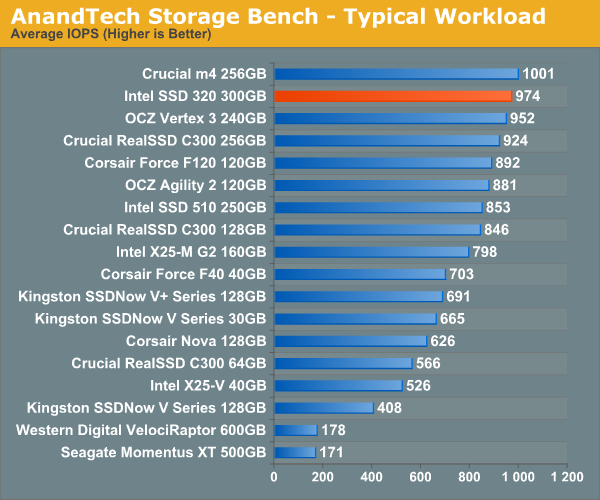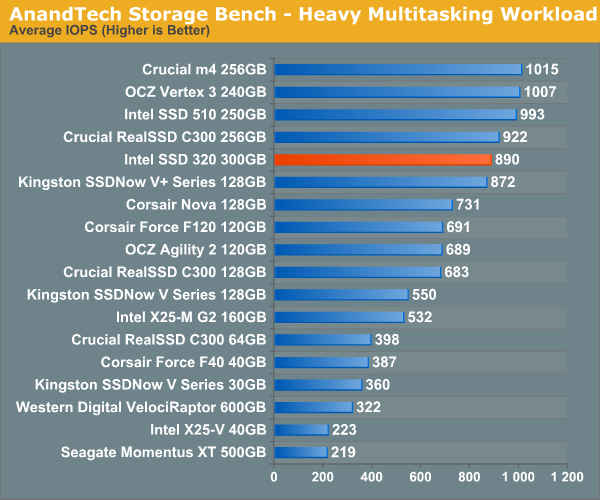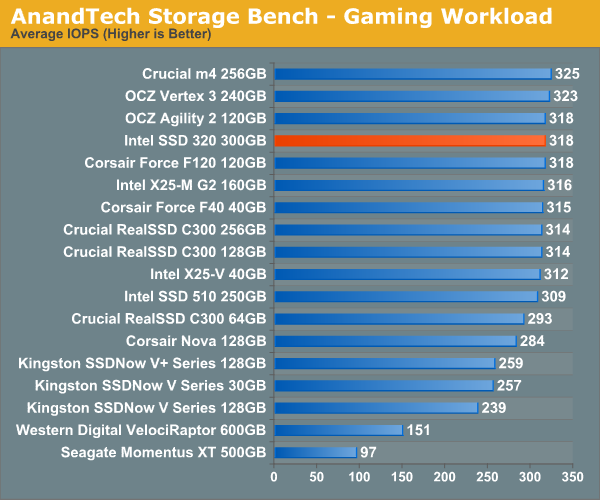The Intel SSD 320 Review: 25nm G3 is Finally Here
by Anand Lal Shimpi on March 28, 2011 11:08 AM EST- Posted in
- IT Computing
- Storage
- SSDs
- Intel
- Intel SSD 320
AnandTech Storage Bench 2010
To keep things consistent we've also included our older Storage Bench. Note that the old storage test system doesn't have a SATA 6Gbps controller, so we only have one result for the 6Gbps drives.
The first in our benchmark suite is a light/typical usage case. The Windows 7 system is loaded with Firefox, Office 2007 and Adobe Reader among other applications. With Firefox we browse web pages like Facebook, AnandTech, Digg and other sites. Outlook is also running and we use it to check emails, create and send a message with a PDF attachment. Adobe Reader is used to view some PDFs. Excel 2007 is used to create a spreadsheet, graphs and save the document. The same goes for Word 2007. We open and step through a presentation in PowerPoint 2007 received as an email attachment before saving it to the desktop. Finally we watch a bit of a Firefly episode in Windows Media Player 11.
There’s some level of multitasking going on here but it’s not unreasonable by any means. Generally the application tasks proceed linearly, with the exception of things like web browsing which may happen in between one of the other tasks.
The recording is played back on all of our drives here today. Remember that we’re isolating disk performance, all we’re doing is playing back every single disk access that happened in that ~5 minute period of usage. The light workload is composed of 37,501 reads and 20,268 writes. Over 30% of the IOs are 4KB, 11% are 16KB, 22% are 32KB and approximately 13% are 64KB in size. Less than 30% of the operations are absolutely sequential in nature. Average queue depth is 6.09 IOs.
The performance results are reported in average I/O Operations per Second (IOPS):

If we strip 6Gbps out of the equation completely, the SSD 320 does very well in our old light workload. You're looking at performance that's at the top of the pack from the mainstream offering.
If there’s a light usage case there’s bound to be a heavy one. In this test we have Microsoft Security Essentials running in the background with real time virus scanning enabled. We also perform a quick scan in the middle of the test. Firefox, Outlook, Excel, Word and Powerpoint are all used the same as they were in the light test. We add Photoshop CS4 to the mix, opening a bunch of 12MP images, editing them, then saving them as highly compressed JPGs for web publishing. Windows 7’s picture viewer is used to view a bunch of pictures on the hard drive. We use 7-zip to create and extract .7z archives. Downloading is also prominently featured in our heavy test; we download large files from the Internet during portions of the benchmark, as well as use uTorrent to grab a couple of torrents. Some of the applications in use are installed during the benchmark, Windows updates are also installed. Towards the end of the test we launch World of Warcraft, play for a few minutes, then delete the folder. This test also takes into account all of the disk accesses that happen while the OS is booting.
The benchmark is 22 minutes long and it consists of 128,895 read operations and 72,411 write operations. Roughly 44% of all IOs were sequential. Approximately 30% of all accesses were 4KB in size, 12% were 16KB in size, 14% were 32KB and 20% were 64KB. Average queue depth was 3.59.

Crank up the workload and the 320 falls a bit behind the rest of the competitors. Last year's heavy multitasking workload is nothing compared to what we introduced earlier this year, so it's still pretty light by comparison but it's clear for normal usage the 320's 3Gbps performance is quite good.
The gaming workload is made up of 75,206 read operations and only 4,592 write operations. Only 20% of the accesses are 4KB in size, nearly 40% are 64KB and 20% are 32KB. A whopping 69% of the IOs are sequential, meaning this is predominantly a sequential read benchmark. The average queue depth is 7.76 IOs.











194 Comments
View All Comments
Ryan Smith - Monday, March 28, 2011 - link
Both the 120GB Vertex 2 and 300GB i320 are fully populated - each has all of their NAND channels in use. Intel does have a lane count advantage (10 vs. 8), but that's a design difference rather than how the SSD is populated. Thus on an architectural level it's fair to compare the controllers, as we're looking at the performance of both when they're fully populated and the architecture is not unnecessarily bottlenecked.Now at equal capacities this wouldn't necessarily be the case. Intel did not provide us with a smaller SSD, which is why Anand said "We also don't have a good idea of how much slower the smaller capacity drives perform in our benchmarks at this point.". It's safe to assume a 120GB i320 won't be fully populated and that it will have lower performance as a result. How much? We don't know.
crimson117 - Monday, March 28, 2011 - link
Thanks for the clarification! I appreciate your reply.I had missed the fact that each drive in the comparison has all its channels in use, so for example a 240GB SF-1200 would have higher capacity chips but would not have any additional channels to write across than a 120GB SF-1200.
Looking forward to the 120GB i320 review; it's much easier on the budget :)
ArteTetra - Monday, March 28, 2011 - link
i320? It sounds no good at all. Please call it with its name.GavinLeigh - Monday, March 28, 2011 - link
What we might have here is the kind of reliability (and hopefully pricing) to appeal to the notebook manufacturers. A 300Gb drive should be plenty for a road-warrior and the performance is definitely a plus over 7200rpm drives. Whole drive encryption could also add to the value in mobile applications.I think this is a smart drive, and I'll definitely consider it.
piquadrat - Monday, March 28, 2011 - link
How Full Disk Encription could add value in mobile applications when everyone can bypass ATA password within seconds using public available tools?DesktopMan - Monday, March 28, 2011 - link
See my response a page or two earlier. The password is used very differently for encrypted drives (that do cryptography correctly).tech6 - Monday, March 28, 2011 - link
While it won't win you bragging rights with your geek friends, the 320s do deliver something that has been missing from existing SSDs: Good enough performance, large capacities and reliability. The 1200 based drives had an unacceptable failure rate for most business/professional users and also couldn't deliver larger capacity drives. If the 2000 series comes in at the same price and is more reliable then Intel has problems and will need to discount but if its like the 1200 then Intel should sell a bunch of these.Chloiber - Monday, March 28, 2011 - link
I agree. The 320 is perfect for my notebook. Vertex 3 would be useless.y.a.k - Tuesday, March 29, 2011 - link
I agree. People say that it's a fail on Intel's part because it's slower than Vertex3. But I'm looking for an SSD for my work notebook, where reliability is even more important than speed. If this drive is as reliable as Intel says, then I'm getting it. And it's not like it's slow or anything.NCM - Tuesday, March 29, 2011 - link
Too many people seem to ignore that there are multiple markets for SSDs, and that they have different requirements beyond the basics. This leads to pointless discussions about the supposed merits of different SSD options. I see three main market segments, each with its own priorities:- Enterprise: Ultra high performance, and whatever you have to pay for that is simply the price of admission for your capacity and performance plan.
- Workstation: High performance boot/application drive, with the extra cost being quite moderate due to the relatively small size drive (~80-120GB) needed. Data can live on a secondary internal drive.
- Portable: Full capacity replacement for low performance standard drives. The typical single storage drive bay means that decent capacity at a reasonable $/GB is the key, not class leading performance.
(Note that reliability isn't a variable. I don't believe that any class of user will knowingly accept lower reliability than that offered by a conventional hard drive. Of course many have…unknowingly.)
This last category is the "good enough" requirement pointed out above by tech6. Sure, the Intel 320 may not be the most exciting new drive around, but notice that at $289 for 160GB or $599 for 300GB it's much less expensive than, say, the OWC Mercury Extreme at $599 for 160GB or—gasp!—$1619 for 400GB.
My own laptop drive is a 500GB with a over 300GB used, but with some housecleaning discipline I could live with the 300GB Intel. And in this application an SSD is like sex: even a bad SSD is good!
My Xserve uses an SSD boot/application drive, and I've set up one of our workstations similarly for evaluation. Boot and application launch times are, not surprisingly, 3-4 times faster with the SSD.